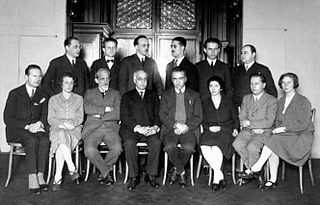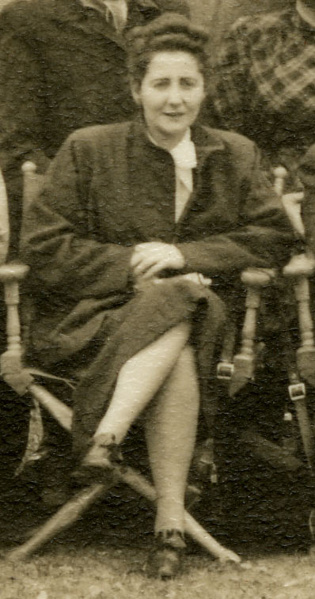Related Research Articles
Neurosis is a term mainly used today by followers of Freudian thinking to describe mental disorders caused by past anxiety, often that has been repressed. In recent history, the term has been used to refer to anxiety-related conditions more generally.

"On the Origin of the 'Influencing Machine' in Schizophrenia" is an article written by Austrian psychoanalyst Victor Tausk. He read it to and discussed it with the Vienna Psychoanalytic Society in January 1918. It was first published in 1919 in the German-language journal Internationale Zeitschrift für Psychoanalyse and, after translation into English by Dorian Feigenbaum, in The Psychoanalytic Quarterly in 1933.
René Árpád Spitz was an Austrian-American psychoanalyst. He is best known for his analysis of hospitalized infants in which he found links between marasmus and death with unmothered infants. Spitz also made significant contributions to the school of ego psychology.
Involutional melancholia or involutional depression is a traditional name for a supposed psychiatric disorder which was thought to affect mainly elderly or late middle-aged people, often in association with paranoia.
Hermann/Herman Nunberg was a psychoanalyst and neurologist.

David Shakow (1901–1981) was an American psychologist. He is perhaps best known for his development of the Scientist-Practitioner Model of graduate training for clinical psychologists, adopted by the American Psychological Association in 1949.

Edmund Bergler was an Austrian-born American psychoanalyst whose books covered such topics as childhood development, mid-life crises, loveless marriages, gambling, self-defeating behaviors, and homosexuality. He has been described as the most important psychoanalytic theorist of homosexuality in the 1950s.

Psychiatry is the medical specialty devoted to the diagnosis, prevention, and treatment of deleterious mental conditions. These include various matters related to mood, behaviour, cognition, perceptions, and emotions.
This is a timeline of the modern development of psychiatry. Related information can be found in the Timeline of psychology and Timeline of psychotherapy articles.

Isador Henry Coriat was an American psychiatrist and neurologist of Moroccan-Jewish descent. He was one of the first American psychoanalysts.
The Psychoanalytic Quarterly is a quarterly academic journal of psychoanalysis established in 1932 and, since 2018, published by Taylor & Francis. The journal describes itself as "the oldest free-standing psychoanalytic journal in America". The current editor-in-chief is Jay Greenberg.

Grete Bibring was an Austrian-American psychoanalyst who became the first female full professor at Harvard Medical School in 1961.

Andrew J. Gerber is an American psychoanalyst and the current president and medical director of Silver Hill Hospital in New Canaan, Connecticut. His principal interests and research lie in studying the neurobiological bases of social cognition, particularly in relation to autism spectrum disorders and change in response to psychotherapy. He is a member of the American Academy of Child and Adolescent Psychiatry, American Psychiatric Association, American Psychoanalytic Association and the Psychoanalytic Psychodynamic Research Society.
Jay R. Greenberg is a psychoanalyst, clinical psychologist and writer. He holds a PhD in Psychology from New York University. He is a Faculty Member of the William Alanson White Institute, where he is also a training analyst and supervisor.
Therese Benedek was a Hungarian-American psychoanalyst, researcher, and educator. Active in Germany and the United States between the years 1921 and 1977, she was regarded for her work on psychosomatic medicine, women's psychosexual development, sexual dysfunction, and family relationships. She was a faculty and staff member of the Chicago Institute for Psychoanalysis from 1936 to 1969.
The New Center for Psychoanalysis is a psychoanalytic research, training, and educational organization that is affiliated with the American Psychoanalytic Association and the International Psychoanalytic Association.
Lawrence Schlesinger Kubie was an American psychiatrist and psychoanalyst who practiced in New York City from 1930 to 1959. Kubie had several celebrity patients, including Tennessee Williams, Leonard Bernstein, Moss Hart, Kurt Weill, Vivien Leigh and Sid Caesar.
Ruth Selke Eissler was a Jewish–American physician and psychoanalyst. She is sometimes known as Ruth Eissler-Selke.

Elisabeth Rozetta Geleerd Loewenstein was a Dutch-American psychoanalyst. Born to an upper-middle-class family in Rotterdam, Geleerd studied psychoanalysis in Vienna, then London, under Anna Freud. Building a career in the United States, she became one of the nation's major practitioners in child and adolescent psychoanalysis throughout the mid-20th century. Geleerd specialized in the psychoanalysis of psychosis, including schizophrenia, and was an influential writer on psychoanalysis in childhood schizophrenia. She was one of the first writers to consider the concept of borderline personality disorder in childhood.
William V. Silverberg was an American psychoanalyst and a founder of the American Academy of Psychoanalysis and Dynamic Psychiatry.
References
- 1 2 "In Memoriam Dorian Feigenbaum, M.D. 1887-1937". The Psychoanalytic Quarterly. 6 (1): 1–3. 1937. doi:10.1080/21674086.1937.11925305 . Retrieved October 20, 2022.
- 1 2 Falk, Avner (2020). Agnon's Story: A Psychoanalytic Biography of S. Y. Agnon . Brill Rodopi Leiden. p. 15. doi:10.1163/9789004367784. ISBN 9789004425422. OCLC 1158896637. S2CID 186853632 . Retrieved October 21, 2022.